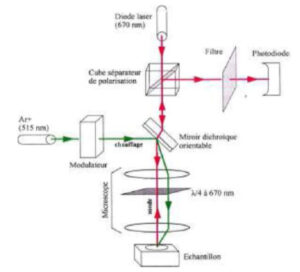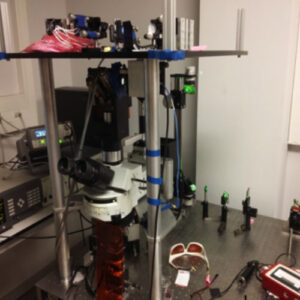List of members |
Facilities |
Internships and jobs |
PhD |
Publications |
News |
Thermo-reflectance Microscopy Assembly
Modulated ThermoReflectance is a non-contact method that allows to follow the heat diffusion in modulated regime induced in a sample and consequently to deduce its thermal properties thanks to the resolution of the heat diffusion equations. Heat diffusion in modulated regime is described by “thermal waves” whose wavelength depends on the modulation frequency and the thermal diffusion D of the material. If the optical properties are not adapted (transparent, semi-transparent or diffusing materials) a gold deposit of about 100 nanometers is deposited on the surface of the sample. This assembly allows the characterization of massive materials (diamond, semiconductor, glass, silica, polymer), layers deposited on substrates (polycrystalline diamond, semiconductor layer…), structured materials (ceramic, solar cell, micro-batteries…).


Caption:Schematic diagram of the principle of thermo-reflectance microscopy.
The surface of the sample is illuminated by a pump beam modulated in intensity (laser 532 nm) and focused (spot about 1 μm in diameter). The wavelength of the pump is chosen to be totally or partially absorbed by the sample. Thermal waves are then excited in the sample and detected on its surface by the change in reflectivity of another focused laser beam (probe beam). We use a laser diode at 488 nm as the probe beam to maximize the sensitivity of the probe to the thermal field when the sample is covered with a thin gold film. The displacement of the pump beam relative to the probe beam is performed by rotation of a dichroic mirror controlled by stepper motors. A photodiode and a synchronous detection record the AC reflectivity component of the sample in a frequency range between 1 kHz and 1 MHz.
Thermoreflectance microscopy does not give direct access to the thermal properties involved in the measured signal, and it is necessary to use physical models of thermal conduction to access the thermal conductivity of materials from experimental data.

